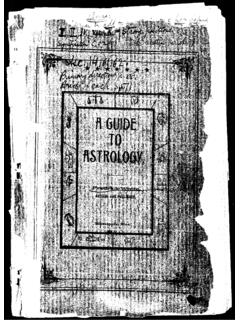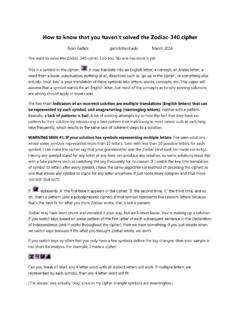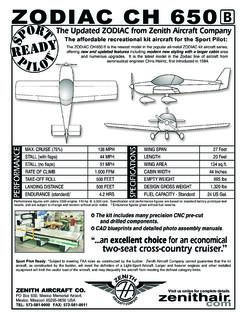Transcription of The Earth, the Sun, and the Constellations of the Zodiac
1 The Earth, the sun , and the Constellations of the Zodiac A. Motions of the Earth The Earth is constantly in motion. It spins on its axis. It also orbits around the sun , with an average distance from the sun of about 150 million kilometers (93 million miles). A third motion of the Earth, known as precession, is less widely known. The Earth bulges slightly at the equator as a result of its rotation, that is, it is not quite a perfect sphere. the sun s and Moon s gravitational pull on the Earth cause the Earth to wobble like a top, or precess. Compare the timescales on which each of these motions occurs. Time it takes Earth to complete one rotation on its axis: 24 hours Time it takes Earth to complete one orbit around the sun : ~365 days Time it takes Earth to complete one precession cycle (Time to trace out one complete circle as it wobbles): 26,000 years (!)
2 Recall that we learned last time that the Earth s axis points close to a particular star. Q1: What special star is this? Q2: Do you think that the Earth s axis will always point at this special star? Why or why not? Explain. It s important to realize that the Earth precesses very slowly. Over a human lifetime, its effect is generally quite negligible. Thus we can use the same pole star for our entire lifetimes, and teach it to our children who can teach it to their children. But as we ll see later in the lab, precession must be taken into account when we are comparing current observations of the sky to observations made thousands of years ago or if we wish to predict what others will see thousands of years in the future. In this lab we will explore the effect of Earth s motions on observations that we make of the sun and the stars over the course of days and months.
3 Precession will not come into play because it happens so slowly. But we will take note of what effect it has on what we see today versus what people saw about 2000 years ago. B. Constellations of the Zodiac Some of the most famous and ancient Constellations are the Constellations of the Zodiac . As we will see in the next part of this exercise, as the Earth orbits the sun , the sun appears to move against the background of stars. (This isn t necessarily obvious, since you can t see stars during the day!) The path that the sun takes through the Constellations is known as the ecliptic, which is the plane defined by Earth s orbit. The Constellations that the ecliptic passes through are the Constellations of the Zodiac , or simply, the Zodiac .
4 For thousands of years, people all over the world have paid attention to the sun s path through the stars. Because of the sun s great importance to our lives, great importance was also attached in many cultures to the Constellations that make up the Zodiac . Q3: Do you know your astrological sign? If so, what is it? Your astrological sign is in principle the constellation that the sun was in on the day you were born. (It is common to say the sun (or a planet) is in a certain constellation. But it s important to understand that it is really in front of that constellation. the sun is much, much closer to Earth than any other star!) Astrological signs, as they ve come down to us, were defined roughly 2000 years ago. At that time, there were 12 zodiacal Constellations , each covering about 1/12th of the ecliptic, so that the sun was in each one for about a month.
5 Since then, the Earth s precession has caused a shift in the position of the sun on different dates. As a result, most people s sign is no longer what it would have been 2000 years ago. We ll see which constellation the sun was actually in on your birthday in a minute. Another change that has occurred is that in the early 20th century, astronomers from all over the world got together and agreed upon a way to divide up the whole celestial sphere into 88 Constellations . You can see the names and outlines of these Constellations on the celestial sphere on the lab table. Some Constellations are big, while others are small, so that the amount of time the sun spends in front of each one is different. Also as a result of this redefinition of the Constellations , there is now one extra constellation that the sun passes in front of over the course of one year.
6 Q4: Starting from the constellation Pisces and moving to the right, along the ecliptic, list all the Constellations of the Zodiac in order on your answer sheet. You should find 13 Constellations along the ecliptic! Notice the dates marked along the ecliptic. Q5: What constellation is the sun in on your birthday? (We ll call this your constellation from now on.) Q6: How does this compare to your astrological sign? If it has shifted, by how many Constellations has it shifted? Q7: Considering how slowly the Earth precesses, how long do you think it might be until your sign would change again? C. Modeling the sun -Earth system Before we model the sun and the signs of the Zodiac , it is helpful to develop a working model of the sun -Earth system.
7 Consider the sketches below. Each sketch represents the Earth at a different time over the course of one day, as viewed from far above the North Pole of Earth. Viewed from above in this way, the Earth spins counterclockwise (as indicated by the arrows). Q8: A little person is shown standing on the equator in each sketch (easier to draw than if they are in California). The dotted line represents the person s horizon. For each sketch, record the approximate time of day (or night) experienced by the person in the sketch on your answer sheet. time #1 time #2 time #3 time #4 Now for the model: the sun will be represented by a light bulb at the center of the room. Your head will be the Earth. Now imagine that the little person in the sketches above is standing on your nose (the equator).
8 What the person would see if they were standing on your nose would be exactly the same as what you see, since that s the side your eyes are on. The field of vision you get by looking all around (without turning your head) is equivalent to the region above the person s horizon. What you can t see (because it s behind you) is what s below the little person s horizon. So in effect you can just use your head as Earth, and your eyes as the little person looking out into space. To get a better sense of where your horizon is, hold your arms out horizontally at your sides. Whatever is in front of them is above your horizon; whatever is behind is below your horizon. Q9: The first diagram on your worksheet, Modeling the Earth & Sun, shows how your head and the light are oriented, corresponding to each of the four positions above.
9 The first position (on the left) is noon, with the nose pointing toward the sun . On each of the four positions, draw in your nose at the position it should be to represent the other three times above, along with the correct times of day. North Pole D. A model of the sun , Earth, and Zodiac Now we ll look at a model of the Zodiac . the sun is at the center of the circle. Remember that you represent the Earth and your nose gives you the time of day. Walk around the sun counterclockwise (remember that Earth both orbits the sun and spins on its axis in the counterclockwise direction). Make one complete orbit, and pay attention to the location of the sun against the Constellations of the Zodiac . Q10: Which way does the sun appear to move against the background of stars over a year: to the left or to the right?
10 Q11: Does the sun actually move significantly over a year? Q12: Is this a scale model of the sun -Earth system and the stars? Why or why not? (Hint: Think about how big Earth is compared to the sun , and how big your head is compared to the light bulb.) The change in perspective resulting from Earth s orbit causes an apparent motion of the sun against the background of stars. The apparent motion caused by the Earth s orbit is known as annual motion. To determine what cardinal direction (east, west, north or south) the sun appears to move along the ecliptic, imagine that your head has a horizon attached to it. If a small person were standing near your nose, then the top of your head is north, your right eye is west, your left eye is east and your chin is south.













